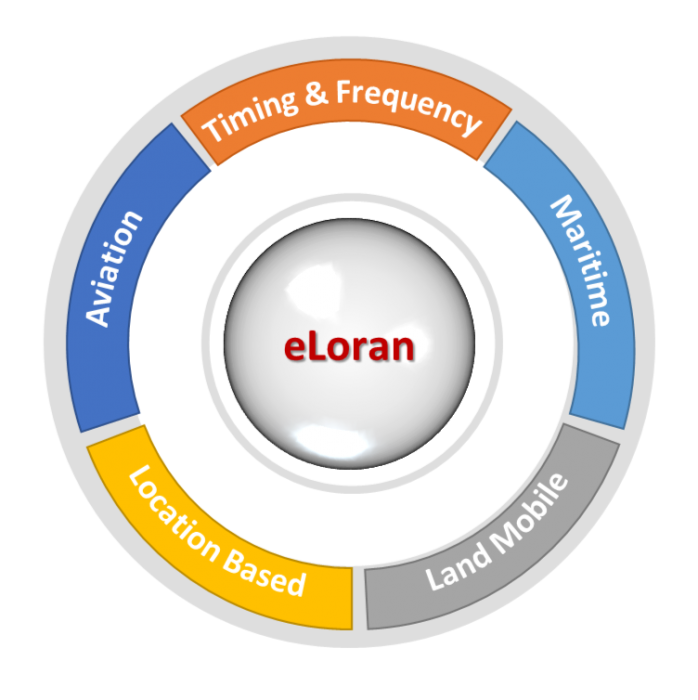 Enhanced Loran (eLoran) is the latest in the longstanding series of low-frequency (LF), LOng-RAnge Navigation (Loran) systems that have met civilian and military (including in-theater) PNT needs for almost 80 years. The most recent instantiation, eLoran, meets the accuracy, availability, integrity, and continuity performance requirements for maritime harbor entrance and approach maneuvers, aviation En Route and Non-Precision Approaches, land-mobile vehicle navigation, and location-based services. It provides bearing (azimuth) information, even when the user is not moving, and has built-in integrity. Users within the coverage area can simultaneously synchronize their timing to absolute (not relative) UTC. Of equal importance is that the eLoran signal includes one or more Loran Data Channels that are available to provide one-way, low data rate, “Short Message Service” information.
Enhanced Loran (eLoran) is the latest in the longstanding series of low-frequency (LF), LOng-RAnge Navigation (Loran) systems that have met civilian and military (including in-theater) PNT needs for almost 80 years. The most recent instantiation, eLoran, meets the accuracy, availability, integrity, and continuity performance requirements for maritime harbor entrance and approach maneuvers, aviation En Route and Non-Precision Approaches, land-mobile vehicle navigation, and location-based services. It provides bearing (azimuth) information, even when the user is not moving, and has built-in integrity. Users within the coverage area can simultaneously synchronize their timing to absolute (not relative) UTC. Of equal importance is that the eLoran signal includes one or more Loran Data Channels that are available to provide one-way, low data rate, “Short Message Service” information.
eLoran is completely independent of GNSS, operates in the internationally protected 90 to 110 kHz spectrum, is built on internationally standardized Loran-C, and provides a high-power PNT service for use by all timing and navigation users. In November 2018, a standards development working group, of which UrsaNav is a founding member, within the Systems Management Council (SMC) of SAE International issued SAE9990™−Transmitted Enhanced Loran (eLoran) Signal Standard. This standard provides technical descriptions of the waveform, specifications, and explanations. The data channel, receiver specification, and recommended practices are described in the SAE9990 family of standards. These standards demonstrate the PNT Committee’s far-reaching vision and purpose of safeguarding the operations of the global economy and critical infrastructure from being overly dependent on single-source PNT services. The RTCM also has maritime-related eLoran standards underway.
eLoran is a key vertex of a Resilience Triad™ that would typically include space-based, terrestrial, and at least one other PNT source. It is a very-wide area (i.e., country wide or “continental”) source of PNT that continues providing a resilient solution even when GNSS may be unavailable or untrustworthy. eLoran delivers information comparable to that of GNSS, but with completely different phenomenology. It is a very high-power, LF, pulsed transmission, whereas GNSS are low-power, UHF, multiple modulation scheme transmissions. eLoran is literally at the other end of the spectrum from GNSS, and has completely dissimilar failure modes. That is, an issue that disrupts GNSS is unlikely to disrupt eLoran. The unique characteristics of eLoran often enable its use in environments where GNSS does not work very well, or at all (e.g., indoors, underwater, underground, and in mountains or urban canyons). Just like other wireless radio frequency solutions, eLoran is not the silver bullet for PNT. There is no single PNT solution that works everywhere, all the time, under all conditions, for all types of users, and that meets all performance requirements. eLoran is, however, an essential part of a system of systems approach to resilient PNT.
eLoran is exceptionally difficult to spoof or jam, and it is nearly impossible to do so at a distance. Just as equipment required to spoof and jam GNSS must mimic relatively low powered GNSS transmissions, spoofing and jamming eLoranrequires very high-powered transmissions. Equipment needs alone to disrupt eLoran over a significant area would be almost prohibitive for any actor other than a nation state engaged in open conflict. This is the reason that an independent assessment by researchers at Stanford University described eLoran as “for all practical purposes, unjammable” across any significant area. A MITRE paper concluded: “…. the robustness of the Loran system under intentional interference is demonstrated.”
